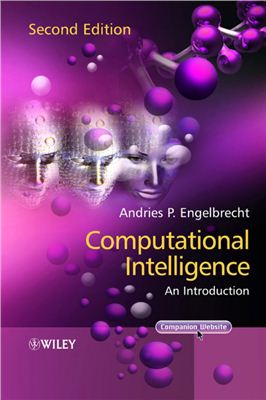Second Edition. - John Wiley & Sons Ltd, 2007. - 630 p.
Man has leaed much from studies of natural systems, using what has been leaed to develop new algorithmic models to solve complex problems. This book presents an introduction to some of these technological paradigms, under the umbrella of computational intelligence (CI). In this context, the book includes artificial neural networks, evolutionary computation, swarm intelligence, artificial immune systems, and fuzzy systems, which are respectively models of the following natural systems: biological neural networks, evolution, swarm behavior of social organisms, natural immune systems, and human thinking processes.
Why this book on computational intelligence? Need arose from a graduate course, where students did not have a deep background of artificial intelligence and mathematics. Therefore the introductory perspective is essential, both in terms of the CI paradigms and mathematical depth. While the material is introductory in nature, it does not shy away from details, and does present the mathematical foundations to the interested reader. The intention of the book is not to provide thorough attention to all computational intelligence paradigms and algorithms, but to give an overview of the most popular and frequently used models. For these models, detailed overviews of different implementations are given. As such, the book is appropriate for beginners in the CI field. The book is also applicable as prescribed material for a third year undergraduate course.
In addition to providing an overview of CI paradigms, the book provides insights into many new developments on the CI research front to tempt the interested reader. As such, the material is useful to graduate students and researchers who want a broader view of the different CI paradigms, also researchers from other fields who have no knowledge of the power of CI techniques, e.g. bioinformaticians, biochemists, mechanical and chemical engineers, economists, musicians and medical practitioners.
The book is organized in six parts. Part I provides a short introduction to the different CI paradigms and a historical overview. Parts II to VI cover the different paradigms, and can be reviewed in any order.
Man has leaed much from studies of natural systems, using what has been leaed to develop new algorithmic models to solve complex problems. This book presents an introduction to some of these technological paradigms, under the umbrella of computational intelligence (CI). In this context, the book includes artificial neural networks, evolutionary computation, swarm intelligence, artificial immune systems, and fuzzy systems, which are respectively models of the following natural systems: biological neural networks, evolution, swarm behavior of social organisms, natural immune systems, and human thinking processes.
Why this book on computational intelligence? Need arose from a graduate course, where students did not have a deep background of artificial intelligence and mathematics. Therefore the introductory perspective is essential, both in terms of the CI paradigms and mathematical depth. While the material is introductory in nature, it does not shy away from details, and does present the mathematical foundations to the interested reader. The intention of the book is not to provide thorough attention to all computational intelligence paradigms and algorithms, but to give an overview of the most popular and frequently used models. For these models, detailed overviews of different implementations are given. As such, the book is appropriate for beginners in the CI field. The book is also applicable as prescribed material for a third year undergraduate course.
In addition to providing an overview of CI paradigms, the book provides insights into many new developments on the CI research front to tempt the interested reader. As such, the material is useful to graduate students and researchers who want a broader view of the different CI paradigms, also researchers from other fields who have no knowledge of the power of CI techniques, e.g. bioinformaticians, biochemists, mechanical and chemical engineers, economists, musicians and medical practitioners.
The book is organized in six parts. Part I provides a short introduction to the different CI paradigms and a historical overview. Parts II to VI cover the different paradigms, and can be reviewed in any order.

